15.10: Renewable Energy Sources
- Page ID
- 153890
\( \newcommand{\vecs}[1]{\overset { \scriptstyle \rightharpoonup} {\mathbf{#1}} } \)
\( \newcommand{\vecd}[1]{\overset{-\!-\!\rightharpoonup}{\vphantom{a}\smash {#1}}} \)
\( \newcommand{\id}{\mathrm{id}}\) \( \newcommand{\Span}{\mathrm{span}}\)
( \newcommand{\kernel}{\mathrm{null}\,}\) \( \newcommand{\range}{\mathrm{range}\,}\)
\( \newcommand{\RealPart}{\mathrm{Re}}\) \( \newcommand{\ImaginaryPart}{\mathrm{Im}}\)
\( \newcommand{\Argument}{\mathrm{Arg}}\) \( \newcommand{\norm}[1]{\| #1 \|}\)
\( \newcommand{\inner}[2]{\langle #1, #2 \rangle}\)
\( \newcommand{\Span}{\mathrm{span}}\)
\( \newcommand{\id}{\mathrm{id}}\)
\( \newcommand{\Span}{\mathrm{span}}\)
\( \newcommand{\kernel}{\mathrm{null}\,}\)
\( \newcommand{\range}{\mathrm{range}\,}\)
\( \newcommand{\RealPart}{\mathrm{Re}}\)
\( \newcommand{\ImaginaryPart}{\mathrm{Im}}\)
\( \newcommand{\Argument}{\mathrm{Arg}}\)
\( \newcommand{\norm}[1]{\| #1 \|}\)
\( \newcommand{\inner}[2]{\langle #1, #2 \rangle}\)
\( \newcommand{\Span}{\mathrm{span}}\) \( \newcommand{\AA}{\unicode[.8,0]{x212B}}\)
\( \newcommand{\vectorA}[1]{\vec{#1}} % arrow\)
\( \newcommand{\vectorAt}[1]{\vec{\text{#1}}} % arrow\)
\( \newcommand{\vectorB}[1]{\overset { \scriptstyle \rightharpoonup} {\mathbf{#1}} } \)
\( \newcommand{\vectorC}[1]{\textbf{#1}} \)
\( \newcommand{\vectorD}[1]{\overrightarrow{#1}} \)
\( \newcommand{\vectorDt}[1]{\overrightarrow{\text{#1}}} \)
\( \newcommand{\vectE}[1]{\overset{-\!-\!\rightharpoonup}{\vphantom{a}\smash{\mathbf {#1}}}} \)
\( \newcommand{\vecs}[1]{\overset { \scriptstyle \rightharpoonup} {\mathbf{#1}} } \)
\( \newcommand{\vecd}[1]{\overset{-\!-\!\rightharpoonup}{\vphantom{a}\smash {#1}}} \)
\(\newcommand{\avec}{\mathbf a}\) \(\newcommand{\bvec}{\mathbf b}\) \(\newcommand{\cvec}{\mathbf c}\) \(\newcommand{\dvec}{\mathbf d}\) \(\newcommand{\dtil}{\widetilde{\mathbf d}}\) \(\newcommand{\evec}{\mathbf e}\) \(\newcommand{\fvec}{\mathbf f}\) \(\newcommand{\nvec}{\mathbf n}\) \(\newcommand{\pvec}{\mathbf p}\) \(\newcommand{\qvec}{\mathbf q}\) \(\newcommand{\svec}{\mathbf s}\) \(\newcommand{\tvec}{\mathbf t}\) \(\newcommand{\uvec}{\mathbf u}\) \(\newcommand{\vvec}{\mathbf v}\) \(\newcommand{\wvec}{\mathbf w}\) \(\newcommand{\xvec}{\mathbf x}\) \(\newcommand{\yvec}{\mathbf y}\) \(\newcommand{\zvec}{\mathbf z}\) \(\newcommand{\rvec}{\mathbf r}\) \(\newcommand{\mvec}{\mathbf m}\) \(\newcommand{\zerovec}{\mathbf 0}\) \(\newcommand{\onevec}{\mathbf 1}\) \(\newcommand{\real}{\mathbb R}\) \(\newcommand{\twovec}[2]{\left[\begin{array}{r}#1 \\ #2 \end{array}\right]}\) \(\newcommand{\ctwovec}[2]{\left[\begin{array}{c}#1 \\ #2 \end{array}\right]}\) \(\newcommand{\threevec}[3]{\left[\begin{array}{r}#1 \\ #2 \\ #3 \end{array}\right]}\) \(\newcommand{\cthreevec}[3]{\left[\begin{array}{c}#1 \\ #2 \\ #3 \end{array}\right]}\) \(\newcommand{\fourvec}[4]{\left[\begin{array}{r}#1 \\ #2 \\ #3 \\ #4 \end{array}\right]}\) \(\newcommand{\cfourvec}[4]{\left[\begin{array}{c}#1 \\ #2 \\ #3 \\ #4 \end{array}\right]}\) \(\newcommand{\fivevec}[5]{\left[\begin{array}{r}#1 \\ #2 \\ #3 \\ #4 \\ #5 \\ \end{array}\right]}\) \(\newcommand{\cfivevec}[5]{\left[\begin{array}{c}#1 \\ #2 \\ #3 \\ #4 \\ #5 \\ \end{array}\right]}\) \(\newcommand{\mattwo}[4]{\left[\begin{array}{rr}#1 \amp #2 \\ #3 \amp #4 \\ \end{array}\right]}\) \(\newcommand{\laspan}[1]{\text{Span}\{#1\}}\) \(\newcommand{\bcal}{\cal B}\) \(\newcommand{\ccal}{\cal C}\) \(\newcommand{\scal}{\cal S}\) \(\newcommand{\wcal}{\cal W}\) \(\newcommand{\ecal}{\cal E}\) \(\newcommand{\coords}[2]{\left\{#1\right\}_{#2}}\) \(\newcommand{\gray}[1]{\color{gray}{#1}}\) \(\newcommand{\lgray}[1]{\color{lightgray}{#1}}\) \(\newcommand{\rank}{\operatorname{rank}}\) \(\newcommand{\row}{\text{Row}}\) \(\newcommand{\col}{\text{Col}}\) \(\renewcommand{\row}{\text{Row}}\) \(\newcommand{\nul}{\text{Nul}}\) \(\newcommand{\var}{\text{Var}}\) \(\newcommand{\corr}{\text{corr}}\) \(\newcommand{\len}[1]{\left|#1\right|}\) \(\newcommand{\bbar}{\overline{\bvec}}\) \(\newcommand{\bhat}{\widehat{\bvec}}\) \(\newcommand{\bperp}{\bvec^\perp}\) \(\newcommand{\xhat}{\widehat{\xvec}}\) \(\newcommand{\vhat}{\widehat{\vvec}}\) \(\newcommand{\uhat}{\widehat{\uvec}}\) \(\newcommand{\what}{\widehat{\wvec}}\) \(\newcommand{\Sighat}{\widehat{\Sigma}}\) \(\newcommand{\lt}{<}\) \(\newcommand{\gt}{>}\) \(\newcommand{\amp}{&}\) \(\definecolor{fillinmathshade}{gray}{0.9}\)- Describe the different renewable energy sources.
- List any impacts it may have on the environment.
Energy sources that are more or less continuously made available in a time frame useful to people are called renewable energy. Renewable energy sources are often considered alternative sources because, in general, most industrialized countries do not rely on them as their main energy source. Instead, they tend to rely on the conventional energy sources such as fossil fuels or nuclear power that are non-renewable. Because of the energy crisis in the United States during the 1970s, dwindling supplies of fossil fuels and hazards associated with nuclear power, use of renewable energy sources such as solar energy, hydroelectric, wind, biomass, and geothermal has grown. Renewable energy comes from the sun (considered an "unlimited" supply) or other sources that can theoretically be renewed at least as quickly as they are consumed. If used at a sustainable rate, these sources will be available for consumption for thousands of years or longer. Renewable alternatives derive from wind, water, solar or biomass (Figure \(\PageIndex{1}\)). Note that wind, water and biomass energy sources are indirect sources of solar energy. One limitation currently associated with most forms of renewable energy is that the energy is not concentrated and not easily portable.

Energy is an important ingredient in all phases of society. We live in a very interdependent world, and access to adequate and reliable energy resources is crucial for economic growth and for maintaining the quality of our lives. The principal energy resources used in the world are shown in Figure \(\PageIndex{2}\). With the rapid growth of electricity generation, renewables—including solar, wind, and hydroelectric power—are the fastest-growing energy source between 2018 and 2050, surpassing petroleum and other liquids to become the most used energy source in the Reference case. Worldwide renewable energy consumption increases by 3.1% per year between 2018 and 2050, compared with 0.6% annual growth in petroleum and other liquids, 0.4% growth in coal, and 1.1% annual growth in natural gas consumption.
Global natural gas consumption increases more than 40% between 2018 and 2050, and total consumption reaches nearly 200 quadrillion Btu by 2050. In addition to the natural gas used in electricity generation, natural gas consumption increases in the industrial sector. Chemical and primary metals manufacturing, as well as oil and natural gas extraction, account for most of the growing industrial demand.
Global liquid fuels consumption increases more than 20% between 2018 and 2050, and total consumption reaches more than 240 quadrillion Btu in 2050. Demand in OECD (Organisation for Economic Cooperation and Development) countries remains relatively stable during the projection period, but non-OECD demand increases by about 45%.
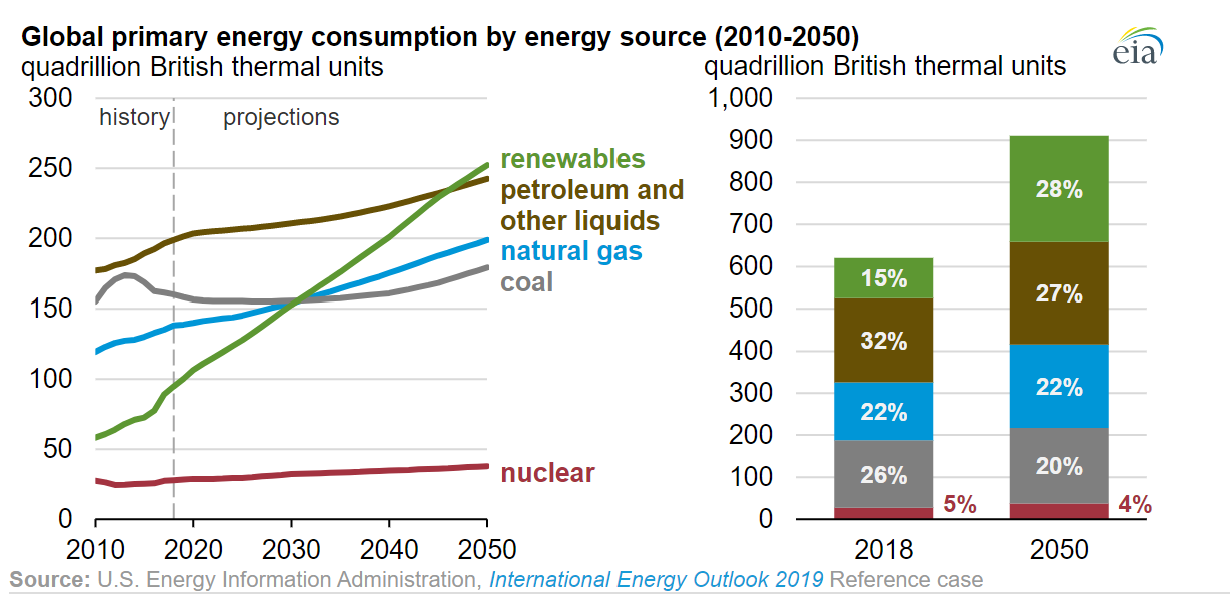
Why Use Renewable Energy Sources?
Majority of renewable energy sources including solar, wind, water, and biomass can be directly or indirectly attributed to the sun. The fact that the sun will continue burning for another 4-5 billion years makes it inexhaustible as an energy source for human civilization. With appropriate technology, renewable energy sources allow for local, decentralized control over power. Homes, businesses, and isolated communities can use sources such as solar to produce electricity without being near a power plant or being connected to a grid. This eliminates problems such as spills associated with extraction and transportation of fossil fuels that is needed in order to supply these fossil fuels to those areas that are lacking. Most renewable energy sources do not pollute the air with greenhouse gas emissions and other air pollutants associated with fossil fuels. This is especially important in combating climate change.
Solar Energy
Solar energy is the ultimate energy source driving life on earth and many human activities. Though only one billionth of the energy that leaves the sun (Figure \(\PageIndex{3}\)) actually reaches the earth's surface, this is more than enough to meet the world’s energy requirement. In fact, all other sources of energy, renewable and non-renewable, are actually stored forms of solar energy. The process of directly converting solar energy to heat or electricity is considered a renewable energy source. Solar energy represents an essentially unlimited supply of energy as the sun will long outlast human civilization on earth. The difficulties lie in harnessing the energy. Solar energy has been used for centuries to heat homes and water, and modern technology (photovoltaic cells) has provided a way to produce electricity from sunlight. There are two basic forms of solar energy collectors are passive and active.
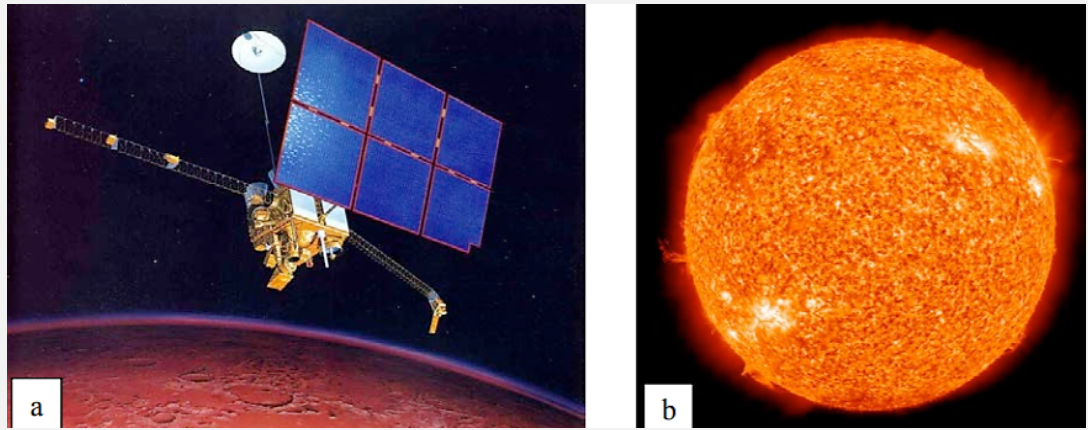
Solar photovoltaic (PV) devices, or solar cells, change sunlight directly into electricity. PV uses semiconducting materials such as silicon to produce electricity from sunlight: when light hits the cells, the material produces free electrons that migrate across the cell, creating an electric current. Small PV cells can power calculators, watches, and other small electronic devices. Arrangements of many solar cells in PV panels and arrangements of multiple PV panels in PV arrays can produce electricity for an entire house or building (Figure \(\PageIndex{4}\)a). Some PV power plants have large arrays that cover many acres to produce electricity for thousands of homes.
Hundreds of thousands of houses and buildings around the world have PV systems on their roofs. Many multi-megawatt PV power plants have also been built. Covering 4% of the world's desert areas with photovoltaics could supply the equivalent of all of the world's electricity. The Gobi Desert alone could supply almost all of the world's total electricity demand.
Solar thermal power plants, like the one in Figure \(\PageIndex{4}\)b use concentrating solar collector systems to collect and concentrate sunlight to produce the high temperature heat needed to generate electricity.
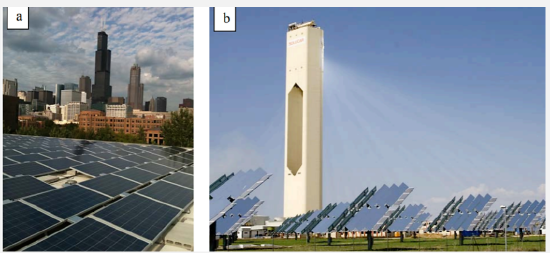
Solar power has minimal impact on the environment, depending on where it is placed. The manufacturing of photovoltaic (PV) cells generates some hazardous waste from the chemicals and solvents used in processing. Often solar arrays are placed on roofs of buildings or over parking lots or integrated into construction in other ways. However, large systems may be placed on land and particularly in deserts where those fragile ecosystems could be damaged if care is not taken. Some solar thermal systems use potentially hazardous fluids (to transfer heat) that require proper handling and disposal. Concentrated solar systems may need to be cleaned regularly with water, which is also needed for cooling the turbine-generator. Using water from underground wells may affect the ecosystem in some arid locations.
Biomass Energy
Biomass energy is from the energy stored in materials of biological origin such as plants and animals. Biomass energy is the oldest energy source used by humans. Until the Industrial Revolution prompted a shift to fossil fuels in the mid-18th century, biomass energy was the world's dominant fuel source. Currently, about 12 percent of the world's energy comes from biomass. Biomass is most frequently used as a fuel source in many developing nations, but with the decline of fossil fuel availability and the increase in fossil fuel prices, biomass is increasingly being used as a fuel source even in developed nations.
Direct combustion of solid biomass. The most common source for direct combustion is wood, but energy can also be generated by burning animal manure (dung), herbaceous plant material (non-wood), peat (partially decomposed plant and animal tissues), or converted biomass such as charcoal (wood that has been partially burned to produce a coal-like substance). Using wood and charcoal made from wood, for heating and cooking can replace fossil fuels and may result in lower CO2 emissions. If wood is harvested from forests or woodlots that have to be thinned or from urban trees that fall down or needed be cut down anyway, then using it for biomass does not impact those ecosystems.
Biomass is also being used on a larger scale, where small power plants are powered by biomass such as woodchips (Figure \(\PageIndex{5}\)). For instance, Central State Hospital, Milledgeville, GA has a woodchip burning plant that was the most advanced system available for its time and operating today. Colgate University in Hamilton, New York, has had a wood-burning boiler since the mid-1980's that processes about 20,000 tons of locally and sustainably harvested wood chips, the equivalent of 1.17 million gallons (4.43 million liters) of fuel oil, avoiding 13,757 tons of emissions, and saving the university over $1.8 million in heating costs. The University's steam-generating wood-burning facility now satisfies more than 75 percent of the campus's heat and domestic hot water needs. For more information about this, click here Colgate University.
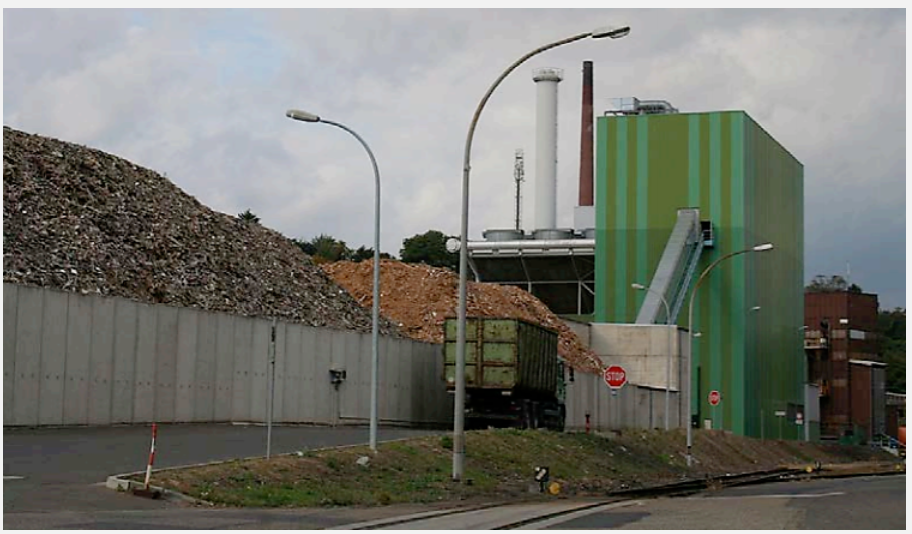
Gaseous Biomass. Organic material can be converted to methane, the main component of natural gas, by anaerobic decomposition or fermentation, a process that utilizes anaerobic bacteria. Methane is a relatively clean fuel that burns efficiently. It can be generated from any kind of organic waste such as municipal sewage and garbage, livestock manure, kitchen, and garden scraps. In fact, municipal landfills are active sites of methane production contributing annually to methane in the atmosphere and to global warming. This gas can and is currently being captured by numerous landfills around the United States that burn it to generate electricity at power plants or supply it to homes for heating.
Liquid Biofuels. Biofuels are transportation fuels produced from plant sources and used to power vehicles. The most common ones are ethanol and biodiesel.
- Ethanol, also known as ethyl alcohol or grain alcohol, is produced by fermenting crops such as corn, sugarcane, and other crops and then mixed with conventional gasoline. As an additive, ethanol lowers reliance on conventional oil and increases the combustion efficiency of gasoline, reducing pollutant emissions.
- Biodiesel which is essentially vegetable oil, can also be derived from a wide range of plant sources, including rapeseed, sunflowers, and soybeans, and can be used in most conventional diesel engines. Biodiesel can also be made from used vegetable oil and has been produced on a very local basis. Because it burns more cleanly than its petroleum-based counterpart, biodiesel can reduce pollution from heavy-duty vehicles such as trucks and buses. Compared to petroleum diesel, biodiesel combustion produces less sulfur oxides, particulate matter, carbon monoxide, and unburned and other hydrocarbons, but more nitrogen oxide.
Environmental Impacts of Biomass Energy
A major challenge of biomass is determining if it is really a more sustainable option. The energy content of some biomass energy sources may not be as high as fossil fuels so more must be burned to generate the same energy. It often takes energy to make energy and biomass is one example where the processing to make it may not be offset by the energy it produces. If traditional monoculture crops like corn or soybeans are used, they require major quantities of fossil fuel to manufacture fertilizer, run farm machines, and ship the fuel to markets, so these biofuels do not always offer significant net energy savings over gasoline and diesel fuel. In such instances, biofuels may not be carbon-neutral because the process of producing the biofuels results in more CO2 added to the atmosphere than that removed by the growing crops.
Burning biomass directly (wood, manure, etc.) produces high particulate material pollution (see chapter 13 on Air Pollution), produces CO2 and deprives the soil of nutrients it normally would have received from the decomposition of the organic matter. Each type of biomass energy source, therefore, must be evaluated for its full life-cycle impact in order to determine if it is really advancing sustainability and reducing environmental impacts.
Hydrogen: Light and Powerful
Hydrogen gas may be an important clean fuel of the future. Hydrogen is considered an energy carrier, like electricity and batteries, it carries energy that can be converted for use later. Hydrogen gas does not tend to exist freely but rather hydrogen atoms bind to other atoms and molecules becoming incorporated in everything from water to organic compounds. Therefore, to obtain hydrogen gas for fuel, energy is needed to force these substances to release their hydrogen atoms. One such procedure is known as electrolysis in which an electric current is passed through water to decompose the water molecule into oxygen and hydrogen (Figure \(\PageIndex{6}\)). Hydrogen can also be produced from hydrocarbons such as natural gas and coal, fermentation of plant waste material, and using algae.

Figure \(\PageIndex{6}\) a) An electric current passed through water resulting in the separation of hydrogen atoms from oxygen to produce the hydrogen fuel. b) An electrolyser used in the production of hydrogen by CambridgeBayWeather. After production the hydrogen is used to inflate weather balloons to which a radiosonde is attached. The oxygen produced is vented to the outside.
Fuel cells are highly efficient power plants that produce electricity using hydrogen fuel in a chemical reaction that is a reverse of the electrolysis process that produced the hydrogen fuel (Figure \(\PageIndex{7}\)). Energy is released by an exothermic electrochemical reaction that combines hydrogen and oxygen ions through an electrolyte material to generate electricity and heat. Experimental fuel cells that can power automobiles have been developed (Figure \(\PageIndex{2}\)).
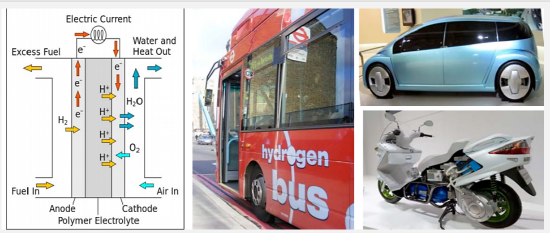
Challenges of Hydrogen
Currently, the infrastructure for using hydrogen fuel is lacking and converting a nation such as the United States to hydrogen would require massive and costly development of facilities to produce, store, transport, and provide the fuel. The environmental impact of hydrogen production itself depends on the source of material used to supply the hydrogen. For example, biomass and fossil fuel sources result in carbon-based emissions. Some research suggests that leakage of hydrogen from its production, transport, and use could potentially deplete stratospheric ozone. Research into this is still ongoing.
Other Renewable Sources
Wind Power
Wind is a renewable energy source that uses the power of moving air to generate electricity. Wind turbines use blades to collect the wind’s kinetic energy. Wind flows over the blades creating lift (similar to the effect on airplane wings), which causes the blades to turn. The blades are connected to a drive shaft that turns an electric generator, which produces electricity (Figure \(\PageIndex{8}\)). Wind turbines are becoming a more prominent sight across the United States, even in regions that are considered to have less wind potential. Wind turbines (often called windmills) do not release emissions that pollute the air or water (with rare exceptions), and they do not require water for cooling. The U.S. wind industry had 40,181 MW of wind power capacity installed at the end of 2010, with 5,116 MW installed in 2010 alone, providing more than 20 % of installed wind power around the globe. According to the American Wind Energy Association, over 35 % of all new electrical generating capacity in the United States since 2006 was due to wind, surpassed only by natural gas.

Most windmills generate about 1kW of electricity, which is only practical for decentralized power generation. California has about 17,000 windmills with a capacity of about 1,400 MW. This is about 80% of all windmills in the U.S. In West Europe windmill generators are quite common. Since a wind turbine has a small physical footprint relative to the amount of electricity it produces, many wind farms are located on crop, pasture, forest land, or coastal areas. They contribute to economic sustainability by providing extra income to farmers and ranchers, allowing them to stay in business and keep their property from being developed for other uses. For example, energy can be produced by installing wind turbines in the Appalachian Mountains of the United States instead of engaging in mountain top removal for coal mining.
Offshore wind turbines on lakes or the ocean may have smaller environmental impacts than turbines on land. Wind turbines do have a few environmental challenges. There are aesthetic concerns to some people when they see them on the landscape. A few wind turbines have caught on fire, and some have leaked lubricating fluids, though this is relatively rare. Some people do not like the sound that wind turbine blades make. Turbines have been found to cause bird and bat deaths particularly if they are located along their migratory path. This is of particular concern if these are threatened or endangered species. There are ways to mitigate that impact and it is currently being researched. There are some small impacts from the construction of wind projects or farms, such as the construction of service roads, the production of the turbines themselves, and the concrete for the foundations. However, overall life cycle analysis has found that turbines make much more energy than the amount used to make and install them.

